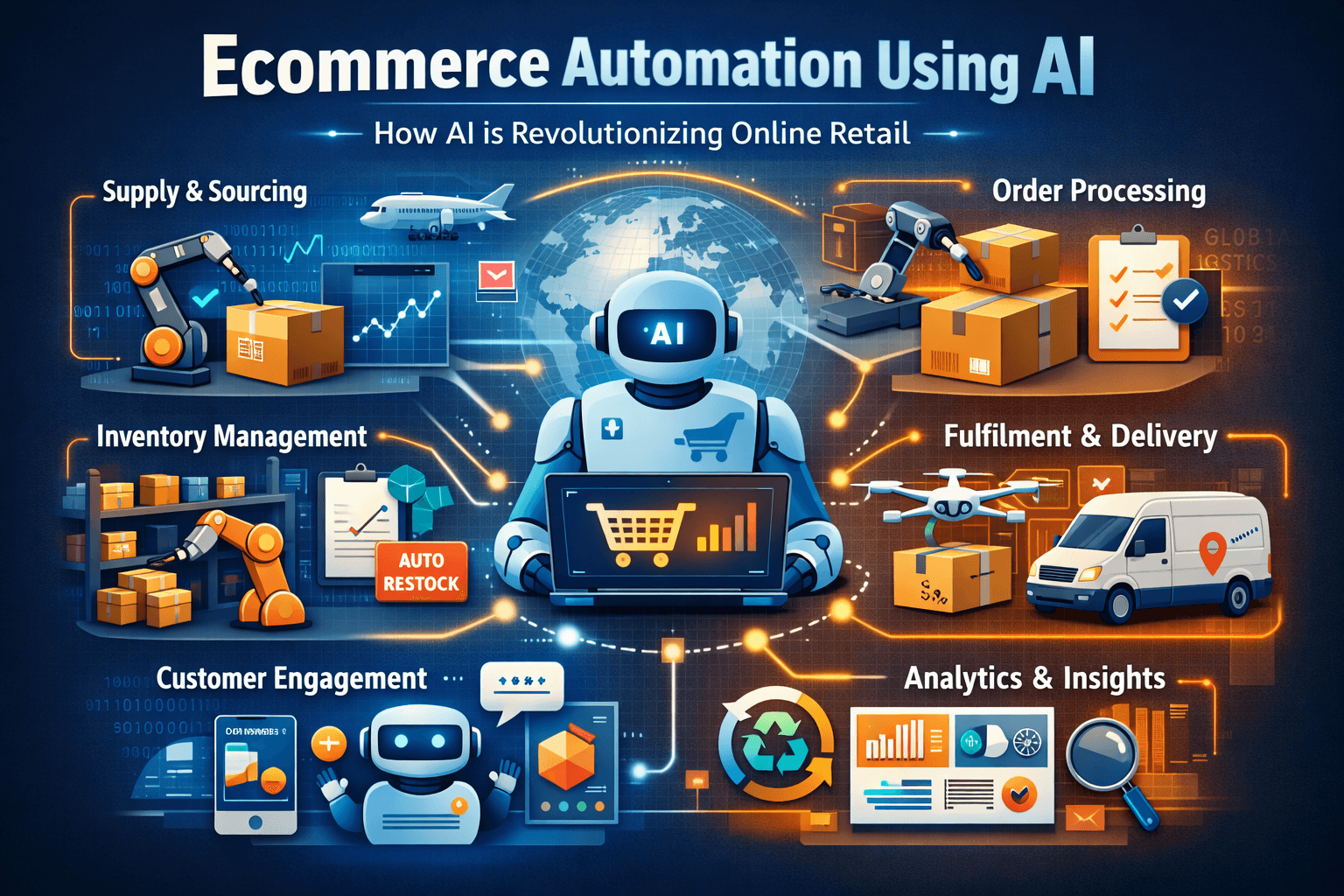How Augmented Reality Retail Shopping Is Changing Fashion?
Best AI Ecommerce Platform for Online Shopping


TL;DR:
AI ecommerce platforms are redefining how we shop online. From personalized recommendations and predictive nudges to AI-powered search, chatbots, and dynamic pricing, these systems eliminate friction at every step of the shopping journey. Platforms like Glance AI lead the way with AI Twins, multi-screen personalization, and real-time engagement, turning browsing into buying across devices. Whether it’s preventing cart abandonment or delivering emotion-driven experiences, the best AI ecommerce platforms are transforming digital storefronts into intelligent, conversational, and human-like shopping companions.
Shopping today isn’t a linear journey—it’s a multi-screen, multi-moment experience. From scrolling through trends on one platform, adding items to a wishlist on another, and abandoning carts halfway due to a distraction or second thought, the path to purchase is filled with friction.
Did you know, nearly 70% of online carts are abandoned, costing businesses billions in lost revenue each year?
Traditional ecommerce platforms have relied on generic reminders and limited personalization to re-engage customers—but in 2025, that’s no longer enough. What shoppers expect is intuitive, real-time guidance that understands their intent, behavior, and lifestyle.
The most advanced AI-powered ecommerce platform of 2025 does the same. With AI Twins, deep personalization, and contextual nudges across screens, it transforms passive browsers into active buyers. In this blog, we explore all about the best ai ecommerce platform.
Core Capabilities of AI Ecommerce Platforms
AI-Powered Personalization at Scale
- Recommends products based on past purchases, browsing patterns, time of day, and even real-time emotional cues.
- Unlike traditional rules-based engines, AI ecommerce platforms use deep learning to continuously refine recommendations with each user interaction.
Example: Glance AI’s “AI Twins” replicate your personas to tailor shopping journeys uniquely across screens.
2. Intelligent Search and Discovery
- Semantic search engines powered by AI understand natural language and shopper intent—not just keywords.
- Visual recognition allows users to upload photos and find similar products instantly.
You will be amazed to know that AI-enhanced site search can generate a 15-20% greater average order value due to better merchandising and product recommendations.
3. Predictive Engagement and Nudging
- AI ecommerce platforms monitor customer hesitation (e.g., long product views, cart inactivity) and trigger timely nudges—discounts, reminders, or social proof.
- These nudges are context-aware: they know when and where to engage users for maximum impact.
4. Real-Time Dynamic Pricing
- AI dynamically adjusts pricing based on demand, inventory, competitor activity, and user interest.
- This helps businesses stay competitive without manual intervention.
Brands using AI-driven pricing tools have seen up to 10–15% lift in revenue, as per data from McKinsey.
5. Conversational Commerce via AI Chatbots
- Modern AI ecommerce platforms come with built-in NLP chatbots that handle product queries, sizing doubts, returns, and support—24/7.
- These bots aren’t just reactive—they proactively suggest products and close sales.
6. Cross-Screen Orchestration
- From smart TVs to smartphones, AI ensures a consistent experience by tracking behavior across multiple devices.
- Platforms like Glance AI offer multi-moment shopping—where context from one device follows users to the next, ensuring continuity and engagement.
7. Cart Recovery and Purchase Optimization
- AI doesn’t wait till after cart abandonment to act—it prevents it.
Platforms like Glance AI identify hesitation and offer real-time nudges, limited-time offers, or helpful reminders, rescuing sales before they’re lost.
Benefits of AI Ecommerce Platforms for Businesses and Shoppers
For Businesses:
- Increased Conversions: With AI-powered personalization, shoppers see what they’re most likely to buy, boosting add-to-cart and purchase rates.
- Lower Cart Abandonment: Intelligent nudging, dynamic incentives, and multi-device continuity help recover up to 30% more abandoned carts.
- Inventory Optimization: AI commerce platforms predict demand patterns and automate restocking, reducing overstock and shortages.
- Cost-Efficient Customer Support: AI chatbots handle up to 80% of customer queries, cutting support costs without compromising service.
- Better Decision-Making: From pricing to promotions, AI platforms provide real-time data and analytics for smarter, faster decisions.
A 2024 study by Deloitte showed that ecommerce businesses using AI ecommerce platforms experienced 18–25% higher revenue per visitor compared to those on traditional platforms.
For Shoppers:
- Hyper-Personalization: Your feed, your cart, your suggestions—tailored uniquely for you.
- Faster Checkout Journeys: Smart fill-in, one-tap payment prompts, and contextual product bundles reduce friction.
- Seamless Omnichannel Experience: Begin your journey on mobile, continue on tablet, and checkout via smart TV—AI remembers it all.
- Real-Time Styling and Fit Assistance: Try-on recommendations using body shape data, occasion-based outfit curation, and AI stylists.
Better Post-Purchase Support: Proactive delivery tracking, instant return processing, and satisfaction-based re-engagement.
Best AI Ecommerce Platforms 2025
2025 has seen major retailers and D2C brands harnessing AI ecommerce platforms to achieve breakthrough results. Let’s look at who’s leading the shift.
1. Glance AI: Multi-Screen Commerce Redefined
- Unique Feature: “AI Twins” personalize journeys across devices—suggesting products based on time of day, location, and previous behavior.
- Use Case: A user browses sneakers on mobile in the morning, and by evening, Glance AI nudges them via smart TV with styled looks, closing the sale.
- Impact: Glance AI helps brands improve cart conversion rates by up to 37% and boosts time spent on-site.
2. Gorgias: AI-Powered Customer Service
- Specializes in AI for post-purchase and customer engagement.
- Automated ticket routing, smart replies, and proactive messaging reduce churn and increase loyalty.
3. Constructor: Search and Product Discovery
- Uses NLP and behavior-based machine learning to show users exactly what they want—even if they can’t describe it well.
- Retailers like Sephora have seen double-digit increases in conversion rates with Constructor AI integrations.
4. Wisepops: AI in On-Site Engagement
- Smart pop-ups and banners powered by AI behavioral predictions.
- Offers segment-based targeting, predicting exit behavior and triggering personalized offers.
Whether it’s Glance AI’s multi-device personalization or Constructor’s dynamic search experience, AI ecommerce platforms are no longer an edge—they're a necessity.
Key Features to Look for in the Best AI Ecommerce Platform in 2025
Not all AI ecommerce platforms are built the same. The best platforms in 2025 go beyond automation—they deliver real-time intelligence, contextual experiences, and business agility. Here are the non-negotiables to look for:
1. Multi-Screen Journey Mapping
- Tracks user behavior across mobile, desktop, smart TV, and even wearables.
- Offers consistent product suggestions and reminders wherever the user continues their shopping journey.
2. AI Twins for Personalization
- Digital personas that learn your preferences—style, budget, color palettes—and recommend accordingly.
- Glance AI leads with this feature, driving emotional engagement and higher AOV (Average Order Value).
3. Predictive Search and Smart Merchandising
- Uses NLP and browsing intent to display hyper-relevant results.
- AI ecommerce platforms like Constructor adjust product rankings based on individual behavior.
4. Real-Time Analytics and Insights
- Dashboards that visualize customer paths, drop-off points, and conversions.
- Helps businesses make agile changes to boost ROI.
5. Built-In Conversational AI
- Not just bots, but AI agents that understand tone, intent, and urgency.
- Platforms like Gorgias improve satisfaction and reduce manual support load.
6. Seamless Integration with Ecosystem
- AI ecommerce platforms must plug into CRM, logistics, email marketing, and social commerce ecosystems without friction.
7. Scalability and Model Customization
- As your business grows, the platform should adapt—supporting new languages, SKUs, geographies, and predictive models tailored to your business.
Choosing the right AI ecommerce platform in 2025 is about aligning smart features with customer-centric goals, not just ticking tech boxes.
How to Choose the Right AI Ecommerce Platform for Your Business?
With many platforms promising the moon, it’s critical to assess your actual needs, budget, and future roadmap before investing.
Step 1: Define Your Objectives
- Want to reduce cart abandonment?
- Improve product discovery?
- Scale customer support?
- Clarify what success looks like for your business.
Step 2: Match Use Cases with Features
Business Goal | Must-Have AI Feature | Recommended Platform |
Reduce cart abandonment | Contextual nudges, multi-screen tracking | Glance AI |
Improve discovery | NLP-driven search, behavioral merchandising | Constructor |
Boost support efficiency | AI chatbot, smart ticket routing | Gorgias |
Increase retention | Personalization, email retargeting | Wisepops, Glance AI |
Sell fashion/lifestyle | Visual search, AI stylists, virtual try-ons | Glance AI, Vue.ai |
Step 3: Evaluate Tech and UX Readiness
- Is your team ready to implement AI workflows?
- Do you have clean data and integrations in place?
- Can the platform be easily managed by your current staff?
Step 4: Pilot and Test
- Start with a limited rollout.
- Measure KPIs like cart conversion, engagement rate, or CSAT score.
- Iterate based on real feedback before full-scale launch.
Pro tip: Look for platforms offering free demos, customizable modules, and white-glove onboarding to minimize the learning curve.
Glance AI: Best AI Commerce Platform for Shoppers Like Us
- Seamless Integration
Glance AI syncs with your mobile device’s lock screen and favorite shopping apps. No complex setup, no new login — just instant, intelligent support whenever you browse or buy. - Meet Your AI Twin
As you interact with products, your AI Twin learns your preferences — from color choices and price sensitivity to browsing behavior and even your mood. It evolves with you, making every suggestion smarter than the last. - Personalized Nudges at the Right Time
Left something in your cart? Glance doesn’t just remind you—it helps you complete the purchase by recommending style pairings, alerting you to deals, or offering options that better match your taste and budget. - Built-in Confidence
With Glance AI, you're never shopping alone. Every suggestion is rooted in real-time data, trend insights, and your unique style—so every purchase feels right, not rushed.
So next time you browse, let Glance AI guide you—not just to shop, but to shop smarter and more confidently
The Future of AI Ecommerce Platforms — What’s Coming Next?
The AI ecommerce platform of 2025 is already miles ahead of traditional systems—but the future promises even more innovation. Here’s what to expect:
Generative AI for Visual Merchandising
- AI will generate personalized product mockups, lifestyle imagery, and ad creatives in real-time.
- Expect ecommerce storefronts that adapt their entire layout per user with dynamic AI-generated content.
2. AI-Powered Voice and Gesture Shopping
- As voice commerce (v-commerce) gains traction, users will shop using voice prompts via smart speakers and AR glasses.
- AI ecommerce platforms will decode natural language intent across age groups and accents.
3. Hyper-Realistic Virtual Try-Ons and Digital Twins
- Advanced 3D modeling and AI avatars will allow users to virtually wear products in real-life settings.
- Platforms like Glance AI are already testing digital twins that replicate your body type, preferences, and shopping history.
4. Sustainable Smart Shopping
- AI will assess the carbon impact of delivery options, suggest eco-friendly alternatives, and track the lifecycle value of products.
- More platforms will integrate with sustainable brands, encouraging responsible consumption.
5. AI-Driven Commerce Communities
- Expect peer-powered product discovery—AI will recommend not only what you like, but what your trusted circles are buying and reviewing.
- Real-time social shopping will be fueled by shared preferences and micro-influencer behavior.
Conclusion
In 2025, ecommerce is no longer about listing products and waiting for customers to find them. It’s about understanding intent, responding in real-time, and making every stage of the shopping journey smarter. From reducing cart abandonment to hyper-personalized product discovery, AI ecommerce platforms are redefining how brands interact with users.
As AI tools become more accessible and scalable, businesses of all sizes—startups to enterprises—can adopt these technologies to improve retention, boost conversions, and build brand loyalty.
Platforms like Glance AI, Constructor, and BigCommerce are leading this shift, showing how deeply integrated AI can transform the traditional ecommerce model. But this is just the beginning.
In a world of endless options, the AI ecommerce platform is the filter that delivers clarity—making digital shopping more intuitive, efficient, and enjoyable than ever.
FAQs Related to AI Ecommerce Platforms
1. What is an AI ecommerce platform?
An AI ecommerce platform is an online selling system that uses artificial intelligence to personalize shopping, automate routine tasks, and improve how customers discover and buy products. It learns from browsing patterns, purchase history, and real-time behavior to show the right products, predict demand, and reduce manual work for sellers. You’ll see it in features like smart recommendations, AI chatbots that answer questions instantly, and automated tools that write product descriptions or optimize search. These platforms also help brands manage inventory more accurately and make faster business decisions, which improves both sales and customer satisfaction.
2. How does AI improve ecommerce conversions?
AI improves ecommerce conversions by making every shopper’s journey feel more personalized and seamless. It studies browsing patterns, previous purchases, and real-time behavior to show products people are most likely to buy, which naturally lifts add-to-cart and checkout rates. It also reduces friction by powering smart search, auto-generated product descriptions, and timely nudges like price-drop alerts or back-in-stock reminders. Many brands use AI chatbots to answer questions instantly, which cuts hesitation and prevents cart abandonment.
3. Can small businesses benefit from AI ecommerce platforms?
Yes. Small businesses gain a lot from AI ecommerce platforms because these tools automate time-consuming work and make every customer interaction feel more personalized. AI helps a small store recommend the right products, write better descriptions, answer customer questions instantly, and manage inventory without guesswork. This means owners spend less time on manual tasks and more on growth. It also levels the playing field, allowing smaller brands to compete with big retailers by running smarter marketing campaigns, improving conversions, and keeping customers engaged across repeat purchases.
4. What features should I look for in an AI-powered ecommerce platform?
Choose a platform that can personalize every shopper’s experience in real time—think tailored product recommendations, dynamic content, and smart search that understands intent. Look for tools that automate work you’d otherwise spend hours on, such as generating product descriptions, running campaigns, and responding to common customer questions through AI chatbots. It also helps if the platform offers predictive analytics for demand, pricing, and inventory so you’re not caught with stockouts or overstock. Strong fraud detection and multi-channel support round things out, making it easier to deliver fast, consistent experiences across web, apps, and social storefronts.
5. Is Glance AI an example of an AI ecommerce platform?
Look for a platform that can personalize the shopping journey automatically—recommending products, adjusting content, and improving search results based on real behavior, not guesswork. It should also generate and optimize product descriptions, images, and campaigns so you don’t have to create everything manually. Strong predictive analytics matter too, because they help you manage inventory, pricing, and demand before problems appear. Smart chatbots for support and built-in fraud detection round out the essentials, making your store faster, more accurate, and easier to scale without extra resources.







